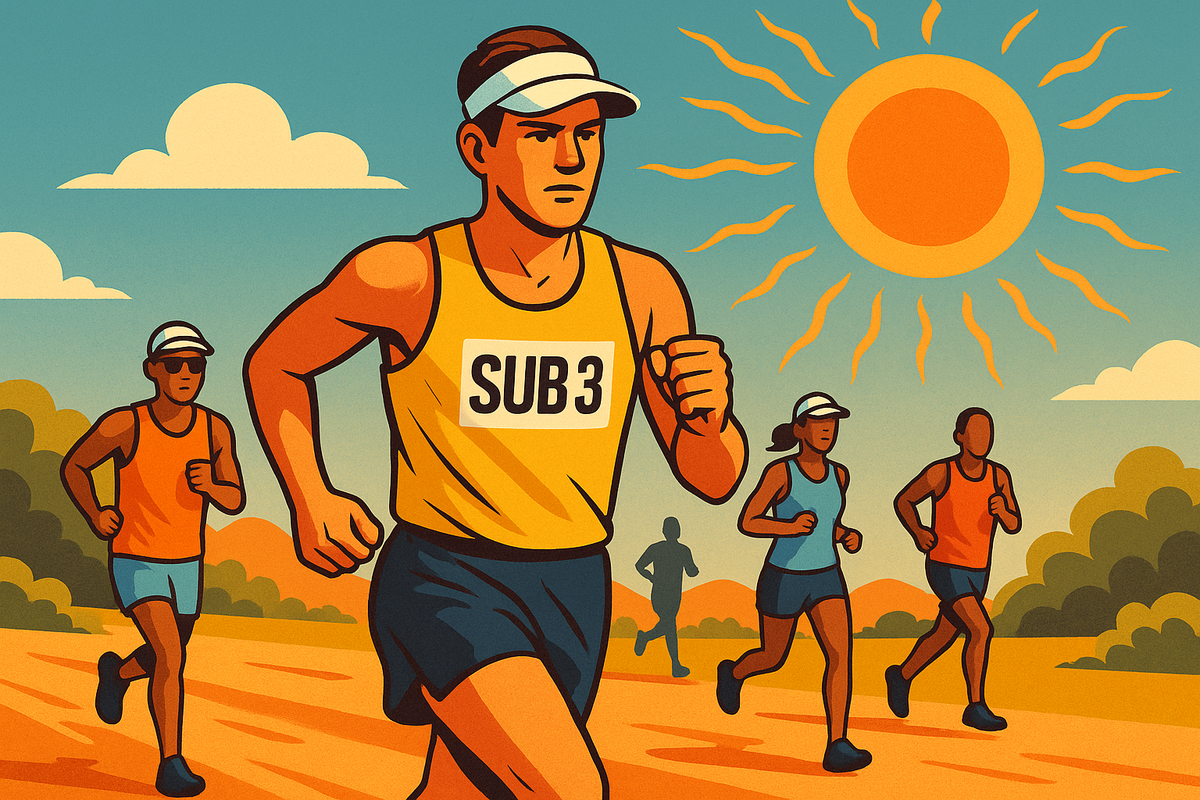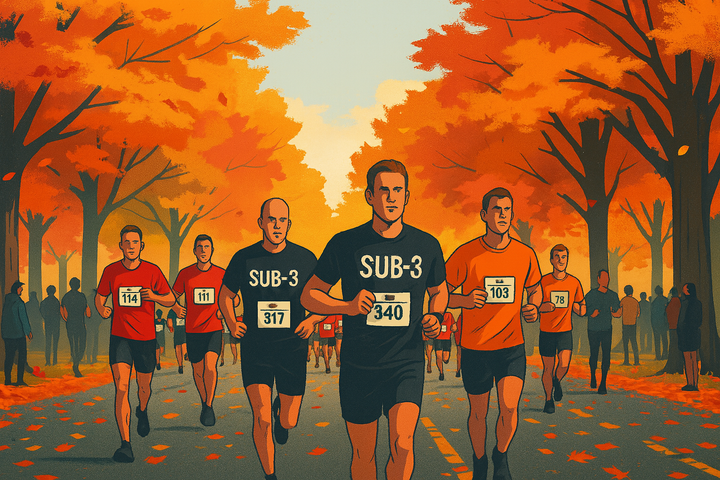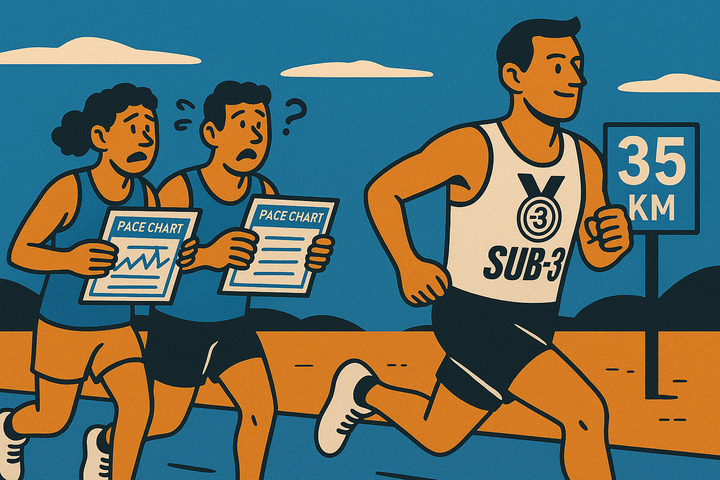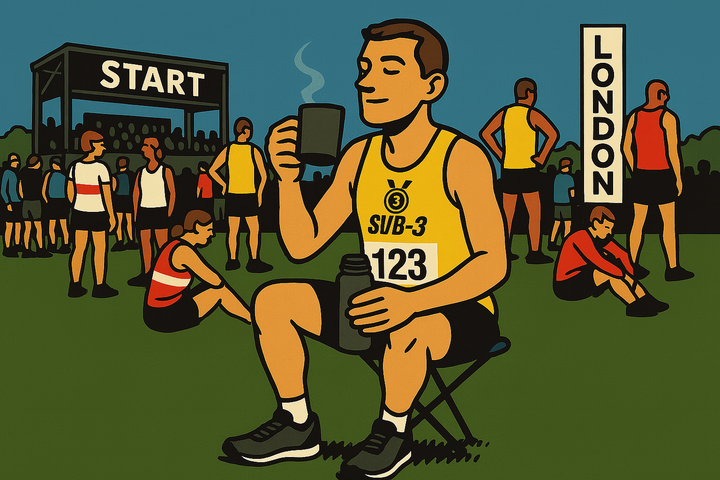10 tips for sub-3 marathon training in the heat
Hot weather can derail even the best training plans — unless you adapt. These ten strategies will help you stay on track for sub-3, no matter the forecast.

Marathon runners are always watching the weather. Rain, wind, humidity, sudden temperature swings - none of it goes unnoticed. But it’s the heat that often causes the most disruption. One moment it’s perfect running weather, the next, you’re red-lining on a steady effort, wondering where all your fitness went.
And race day can be worse. Take the London Marathon 2025. Conditions in the days leading up to it were relatively cool, with highs in the mid-teens. But on race day itself - Sunday 27 April - temperatures surged unexpectedly to over 24°C. Thousands of runners felt it, and for many, even well-laid pacing strategies started to unravel by halfway.
When temperatures rise, effort increases, and the body diverts blood flow away from muscles to stay cool. That means slower paces, higher heart rates and a much greater risk of blowing up. You can still train well and race smart in the heat - but you have to adapt.
Here are ten hard-earned tips for managing heat while still chasing sub-3.
1. Expect effort to stay the same, even if pace doesn’t
On hotter days, your usual pace may not be available to you. The same level of effort that gives you 3:45/km in 12°C might only yield 3:55/km when it’s 25°C. Don’t fight it - work with it. If you try to force goal pace regardless of conditions, you're setting yourself up for a blow-up. Effort is what counts.
And on race day, if you feel yourself overheating in the first 10K, don’t double down - adjust your target pace early. The goal becomes finishing strong, not clinging to fantasy splits.
2. Acclimate at the time of day you’ll race
If your marathon starts at 10am in warm conditions, try to replicate that in your training. Running in the heat of the day during your final sessions helps your body adapt to the conditions it’ll face on race day. It’s not always convenient, especially if you’re training in the UK for an overseas race. And not always possible if the sun springs a surprise visit, as it did in London 2025. But even a couple of heat-specific sessions, or failing that 10-15 minute sauna sessions - can make a difference.
3. Hydration is non-negotiable - before, during and after
Hot weather means higher sweat loss, even on shorter runs. I never head out without my 250ml soft Salomon flask, worn in a secure Camelbak belt that doesn’t bounce. For longer efforts, consider a looped route with a bottle drop or make sure you can access fountains.
Aim to stay ahead of dehydration rather than chase it. Pre-hydrate well in the hours before your run. You may lose 1–2L of fluid per hour in hot conditions - far more than you can realistically replace mid-run. The aim isn’t full replenishment, but smart mitigation.
4. Supplement electrolytes, not just water
On long, hot runs, plain water won’t cut it. You’re losing electrolytes - particularly sodium, potassium and magnesium - which can impair performance and increase the risk of cramp or fatigue. I’ve used SaltStick caps during long runs, but Precision Hydration and similar mixes can all help.
You might also try sodium preloading the evening before a key session with a slightly saltier meal or an electrolyte tab in your water. It’s a simple way to improve fluid retention ahead of a tough effort.
5. Reframe your mental approach: everyone is suffering
When things heat up, remind yourself that it’s not just your race plan going up in smoke. Most of the field is hurting. Focus on position, not pace, especially if racing competitively. Websites like Run Britain even apply an SSS (Standard Scratch Score) that takes weather and conditions into account - so that “slower” result may be more valuable than it looks. A borderline sub-3 attempt may be postponed, however - but that can wait. Health must trump sub-3 success.
6. Kit choice matters more than you think
Caps can trap heat. I learned this the hard way at Valencia 2024, where I ditched an expensive cap just 2km into the race. If you need shade, a visor is the better choice - assuming you have hair - especially if you plan to pour water over your head. Singlets are a must, and sun cream is non-negotiable - just avoid overapplying around the eyes, as obviously sun cream mixed with salty sweat can really sting your eyes.
Also worth experimenting with during training: exactly how your kit handles heat, sweat and friction. Practice makes discomfort more manageable.
7. Use palmar cooling - seriously
It might sound like a niche trick, but palmar cooling has scientific backing (read the excellent Run Elite by Andrew Snow). The palms contain special blood vessels that are particularly effective at releasing heat. I sometimes carry instant ice packs in races - just squeeze to activate. I used two during the second half of London 2025, and whether through physiology or placebo, they helped me hold form and finish with a PB. Just follow instructions carefully. I've used real ice in pouches shaped like batons in other races to good effect.
If you’re racing in heat, consider practising this in training so it doesn’t feel unfamiliar.
8. Adjust your warm-up - don’t waste energy
There’s no point in emptying the tank before the race even starts. On a cool day, a longer warm-up may make sense. But in the heat, your core temperature rises fast. A short jog, some drills and a few strides is enough. (Maybe not even that - you will warm up quickly on the course). The goal is to be loose, not already flushed and fatigued before the gun goes.
And if the forecast is extreme, consider pre-cooling. A cold drink, wet towel or staying in air-conditioning as long as possible before the start can reduce early stress on the system. I've even found a cold bath - if you can stand it, and one is available close enough to start time - can work wonders in reducing core temperature.
9. Prioritise cooling post-run
Recovery doesn’t stop at stopping. In the heat, your system remains stressed for longer, so help it reset. Use cold water (showers, hosepipes, a wet towel round the neck), eat water-rich foods (melon, cucumber, citrus) and get off your feet if you can. If you’re training again soon, the faster you bring your core temperature down, the better.
10. Be prepared to adjust your race goal
No one trains for months hoping to compromise on the day. But in extreme heat, it might be the smart choice. Sub-3 is a demanding effort even in ideal conditions - if it’s 30°C and cloudless, your body might not give you what you want, no matter how hard you push. Don’t let pride ruin your race.
Sometimes, adjusting the goal lets you run to your potential within the conditions, but it usually requires a slower-than-usual start to adapt to the temperatures. If you're feeling strong, then push harder later in the course for a fast finish.
Final thought
You don’t have to love running in the heat - few people do - but you do have to respect it. Adapt your sessions, modify your expectations and use every tool at your disposal. The goal isn’t to beat the weather, but to perform as best as you can given imperfect conditions.
Enjoyed this article? Help keep Sub-3 running — support us with a coffee.
To help fund the running of the site, Sub-3 is an Amazon Associate and earns from qualifying purchases. We only recommend gear or kit that has genuinely helped in our own running and that we believe is worth considering.



